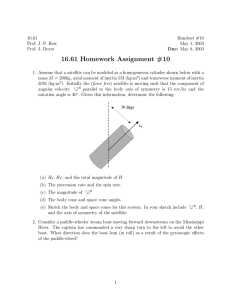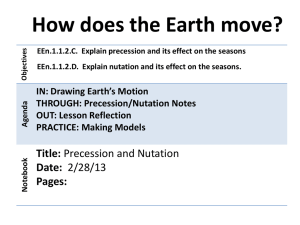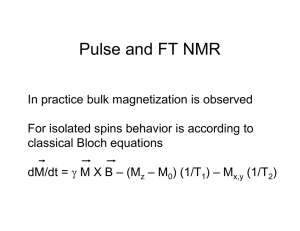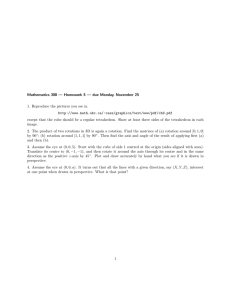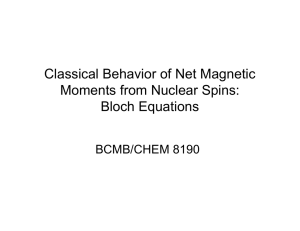FLUID DYNAMOS AND PRECESSION DRIVING J.Léorat Observatoire de Paris-Meudon, 92195-Meudon, France Summary
advertisement
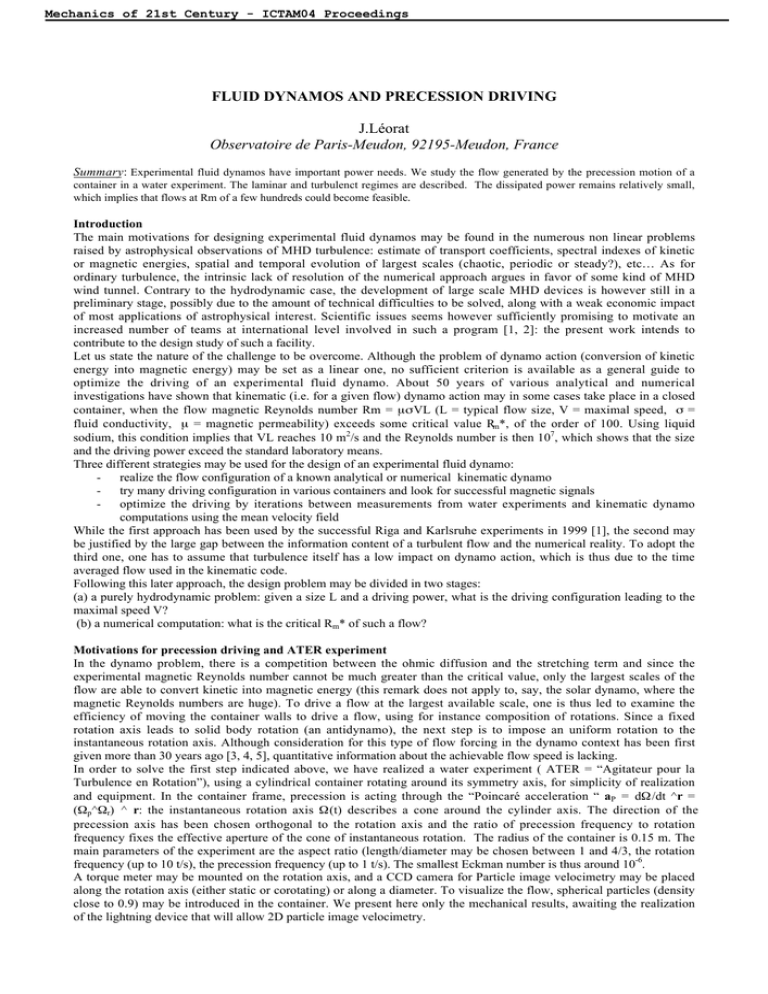
Mechanics of 21st Century - ICTAM04 Proceedings FLUID DYNAMOS AND PRECESSION DRIVING J.Léorat Observatoire de Paris-Meudon, 92195-Meudon, France Summary: Experimental fluid dynamos have important power needs. We study the flow generated by the precession motion of a container in a water experiment. The laminar and turbulenct regimes are described. The dissipated power remains relatively small, which implies that flows at Rm of a few hundreds could become feasible. Introduction The main motivations for designing experimental fluid dynamos may be found in the numerous non linear problems raised by astrophysical observations of MHD turbulence: estimate of transport coefficients, spectral indexes of kinetic or magnetic energies, spatial and temporal evolution of largest scales (chaotic, periodic or steady?), etc… As for ordinary turbulence, the intrinsic lack of resolution of the numerical approach argues in favor of some kind of MHD wind tunnel. Contrary to the hydrodynamic case, the development of large scale MHD devices is however still in a preliminary stage, possibly due to the amount of technical difficulties to be solved, along with a weak economic impact of most applications of astrophysical interest. Scientific issues seems however sufficiently promising to motivate an increased number of teams at international level involved in such a program [1, 2]: the present work intends to contribute to the design study of such a facility. Let us state the nature of the challenge to be overcome. Although the problem of dynamo action (conversion of kinetic energy into magnetic energy) may be set as a linear one, no sufficient criterion is available as a general guide to optimize the driving of an experimental fluid dynamo. About 50 years of various analytical and numerical investigations have shown that kinematic (i.e. for a given flow) dynamo action may in some cases take place in a closed container, when the flow magnetic Reynolds number Rm = msVL (L = typical flow size, V = maximal speed, s = fluid conductivity, m = magnetic permeability) exceeds some critical value Rm*, of the order of 100. Using liquid sodium, this condition implies that VL reaches 10 m2/s and the Reynolds number is then 107, which shows that the size and the driving power exceed the standard laboratory means. Three different strategies may be used for the design of an experimental fluid dynamo: - realize the flow configuration of a known analytical or numerical kinematic dynamo - try many driving configuration in various containers and look for successful magnetic signals - optimize the driving by iterations between measurements from water experiments and kinematic dynamo computations using the mean velocity field While the first approach has been used by the successful Riga and Karlsruhe experiments in 1999 [1], the second may be justified by the large gap between the information content of a turbulent flow and the numerical reality. To adopt the third one, one has to assume that turbulence itself has a low impact on dynamo action, which is thus due to the time averaged flow used in the kinematic code. Following this later approach, the design problem may be divided in two stages: (a) a purely hydrodynamic problem: given a size L and a driving power, what is the driving configuration leading to the maximal speed V? (b) a numerical computation: what is the critical Rm* of such a flow? Motivations for precession driving and ATER experiment In the dynamo problem, there is a competition between the ohmic diffusion and the stretching term and since the experimental magnetic Reynolds number cannot be much greater than the critical value, only the largest scales of the flow are able to convert kinetic into magnetic energy (this remark does not apply to, say, the solar dynamo, where the magnetic Reynolds numbers are huge). To drive a flow at the largest available scale, one is thus led to examine the efficiency of moving the container walls to drive a flow, using for instance composition of rotations. Since a fixed rotation axis leads to solid body rotation (an antidynamo), the next step is to impose an uniform rotation to the instantaneous rotation axis. Although consideration for this type of flow forcing in the dynamo context has been first given more than 30 years ago [3, 4, 5], quantitative information about the achievable flow speed is lacking. In order to solve the first step indicated above, we have realized a water experiment ( ATER = “Agitateur pour la Turbulence en Rotation”), using a cylindrical container rotating around its symmetry axis, for simplicity of realization and equipment. In the container frame, precession is acting through the “Poincaré acceleration “ aP = dW/dt ^r = (Wp^Wr) ^ r: the instantaneous rotation axis W(t) describes a cone around the cylinder axis. The direction of the precession axis has been chosen orthogonal to the rotation axis and the ratio of precession frequency to rotation frequency fixes the effective aperture of the cone of instantaneous rotation. The radius of the container is 0.15 m. The main parameters of the experiment are the aspect ratio (length/diameter may be chosen between 1 and 4/3, the rotation frequency (up to 10 t/s), the precession frequency (up to 1 t/s). The smallest Eckman number is thus around 10-6. A torque meter may be mounted on the rotation axis, and a CCD camera for Particle image velocimetry may be placed along the rotation axis (either static or corotating) or along a diameter. To visualize the flow, spherical particles (density close to 0.9) may be introduced in the container. We present here only the mechanical results, awaiting the realization of the lightning device that will allow 2D particle image velocimetry. Mechanics of 21st Century - ICTAM04 Proceedings Laminar and turbulent flows We begin by a qualitative account of what is observed visually, as the precession frequency is increased step by step, starting from zero, for a fixed rotation frequency. At zero precession frequency, particles tend to align in the vicinity of the cylinder axis, due to the action of buoyancy in the centrifugal pressure field. A soon as precession is present, the central concentration of particles form a wavy thin tube, quasi steady in the precession frame, showing that the line of zero speed is now a 3D curve, which deviate from the rotation axis as the precession increases. Advected particles outside the wavy core suggest that the tilted streamlines are also steady in the precessing frame. Above a critical precession frequency, the flow becomes suddenly turbulent: the size of the time dependent streamlines drops to a fraction of the radius. This turbulence looks remarkably homogeneous and statistically steady. When decreasing the precession frequency (still keeping a constant rotation rate), one recovers the laminar flow, at a critical precession frequency lower than for the transition from laminar to turbulent (hysteresis). The rotation torque increases smoothly with the precession rate in the laminar regime and shows a jump at the critical precession frequency, followed by a plateau. When the precession decreases, an hysteresis curve is obtained. Some insight on the laminar regime may be obtained from the linearised equations, while the stability analysis remains to be done (see for example [6] for the precessing ellipsoid case). The Navier-Stokes equations are adimensionalised using the container radius and the rotation period as units. If the viscous dissipation term is neglected (the Eckman number is small), the only remaining parameter in the dynamical equations is the precession rate h, defined by the ratio of the precession frequency to the rotation frequency. Using different rotation speeds to study the transitions from laminar to turbulence (noted +) and back (noted -), one find that the critical rates (h+ and h-) are indeed independent of the rotation frequency. They depend on the aspect ratio: for example, they are close to 0.1 when the aspect ratio is 4/3. The secondary flow induced by precession scales with the precession rate. To get higher speed in the laminar regime, which is potentially efficient for dynamo action (flow at large scale) and less power demanding in term of driving, one has to find higher critical rates. This can be done by exploring different values of the aspect ratio. Another tool has been successfully tested: since the stability of the laminar flow at such high Reynolds numbers could be a consequence of rotation motion, we have fixed four radial blades on one top of the cylindrical container to enforce rotation motion: The blade velocity is parallel to its normal, whereas it is tangent to the wall for the curved cylindrical wall. Rotation is now driven by pressure/inertial forces instead of viscous forces. Using blades with height equal to 1/10 of the container length allows to double the critical precession rates (for aspect ratio = 4/3, h+ = 0.215, h - = 0.175), and thus to double also the maximal speed V in the laminar regime. The gain in driving efficiency is important. Power scaling In the turbulent regime, at sufficiently small scales, the influence of rotation becomes negligible, Kolmogorov phenomenology of homogenous isotropic turbulence may apply, and the non-linear energy flux scales as (rV02)/(L0/V0), where L0 and V0 are defining the “energy range”. Although they are not directly measurable, they are related to the container geometry (length L, radius R) and the driving design (be it external pump, internal turbines or precession), so that the values of the ratio L0/R and V0/Vc are characteristics of each configuration. As a consequence, when viscous dissipation at the smallest scales is fed by a turbulent cascade, the dissipated power per unit volume scales a priori as Pdiss = brVc3/R, where the power coefficient b represents a concentrate of the driving characteristics. The scaling with container speed of the dissipated power in the turbulent regime cubic law has been verified in the ATER experiment, and the power coefficient b has been found close to 0.02 for precession driving. In the optimization stage of an MHD wind tunnel, one has to compare power needs for a given magnetic Reynolds number, i.e. a typical flow speed V. In the case of precession with radial blades, V may reach about 2 h+ Vc in the laminar regime (with dissipated power lower than in the turbulent regime). Such values may also be extrapolated from numerical studies up to Reynolds number 5000 (cf P. Lallemand, priv. com.), and have to be confirmed with the PIV under realization. Conclusion Precession driving looks as a promising tool to get high Rm flows. Since typical powers of a few hundred of kW are considered in the design of experimental fluid dynamos, its power scaling is compatible with the realization of MHD flows at magnetic Reynolds numbers of a few hundreds. Compared to turbine driving, it has also the technical advantage to use a closed container and avoid seals in liquid sodium. To confirm this favorable position and take advantage of it in an experimental fluid dynamo, critical magnetic Reynolds numbers must now be obtained. References [1] A.Gailitis, O.Lielausis, E.Platacis, G.Gerbeth, F.Stefani, ”Laboratory experiments on hydromagnetic dynamos”, Rev. Mod. Physics, 74, 973-990 (2002) [2] « Dynamo and Dynamics, A Mathematical Challenge », Cargèse Workshop, August 21-26, 2000, Lecture Notes in Physics, Eds. P. Chossat, D. Armbruster, I. Oprea [3] W. Malkus, “ Precession of the Earth as the cause of geomagnetism”, Science, 169, 259-264 (1968) [4] R.F. Gans, “On the precession of a resonant cylinder”, J. Fluid Mech., 41, 865-872 (1970) [5] R.F. Gans, “On hydromagnetic precession in a cylinder”, J. Fluid Mech., 45, 11-130 (1970) [6] R. Kerswell, “The instability of precessing flows “, Geophys. and Astroph. Fluid Dyn., 72,107-144, 1993. << session << start
